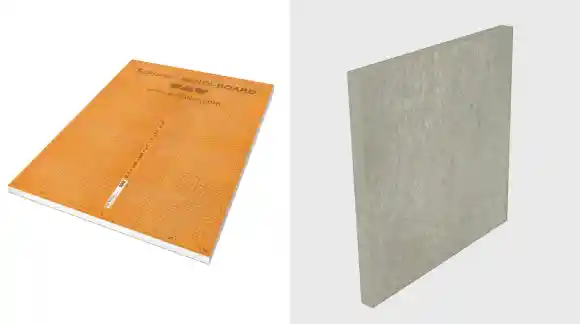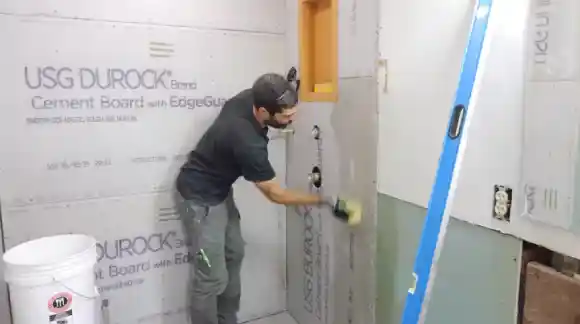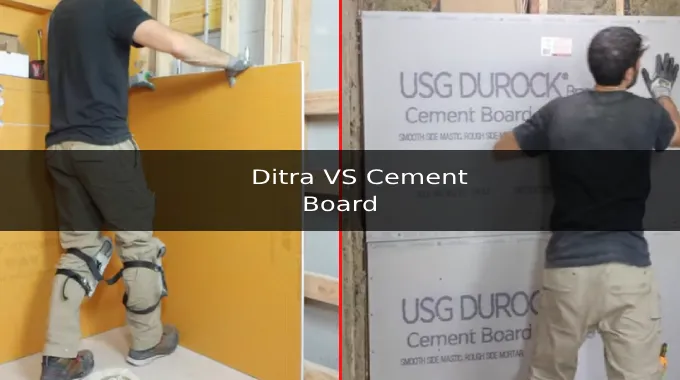Last Updated on August 2, 2023
When tiling projects, using the proper underlayment is crucial. Two popular underlayment choices are Ditra & cement board. While both serve the same purpose of supporting tiles, they differ significantly in their material composition, weight, and thickness.
Ditra’s pliability & flexibility, combined with its lightweight and thin profile, make it an excellent choice for many applications. Alternatively, cement board strength and durability are ideal for areas requiring a sturdy base, like high-traffic floors.
Here, we’ll examine the differences between Ditra and cement board and help you decide on your next tiling project. Let’s get started and find out which underlayment best fits your needs.
The Differences Between Ditra vs Cement Board

Ditra and cement boards are used for tile installation but have some key differences. Here are the main distinctions between Ditra and cement board:
- Composition
- Uncoupling Properties
- Weight and Thickness
- Installation Method
- Waterproofing
- Flexibility
01: Composition
You’ll love how the composition of one option is like a lightweight grid while the other is rigid and sturdy.
Ditra is made of polyethylene material that gives it its pliability and flexibility. It has a grid-like structure that allows for movement between the tiles and subfloor without damaging either.
Meanwhile, the cement board is composed of cementitious materials like cement and fiberglass mesh. This combination makes it strong and durable but not as flexible as Ditra. The difference in composition affects their ability to absorb movement or shock from foot traffic.
02: Uncoupling Properties
While cement board does provide some minimal uncoupling properties, it’s primarily used as a flat, stable substrate for tile installation.
Conversely, Ditra is specifically designed as an uncoupling membrane that allows for independent movement between the tile and substrate. This separation layer absorbs stress and prevents cracks in the tile caused by subfloor movement.
By using Ditra, you can ensure a longer-lasting and more durable tile installation with fewer chances of cracking or damage over time.
03: Weight and Thickness

Looking for a lighter and thinner option for your tile installation? Ditra might just be what you need. Compared to cement boards, Ditra is considerably lighter and thinner. It is around 1/8 inch (3 mm), whereas cement board usually has a thickness of 1/2 inch (12 mm).
The weight difference between the two materials is significant, which may become an important factor in certain installations. If weight or thickness concerns your project, consider using Ditra instead of a cement board.
04: Installation Method
For a successful tile installation, the method of installation is just as important as the weight and thickness of the material. One of the important differences between Ditra and cement boards is how they are installed.
Ditra is installed directly on top of the substrate with a thin-set mortar. A cement board requires screws or nails to attach to the substrate before applying thin-set mortar. This means installing Ditra is faster and easier than cement board, especially in large areas.
05: Waterproofing
Both materials require proper waterproofing before tile installation to prevent moisture damage over time. If you neglect proper waterproofing measures, your tile installation will become a waterlogged disaster waiting to happen.
While Ditra provides some degree of waterproofing due to its polyethylene composition, it isn’t considered a waterproofing membrane on its own. The cement board itself also isn’t waterproof and requires additional measures to prevent water damage.
In areas prone to water exposure, like showers, it’s crucial to use a waterproofing membrane or a liquid waterproofing product in addition to Ditra or cement board. Properly addressing the issue of moisture can prevent costly repairs down the line.
06: Flexibility

You can ensure your tile installation can withstand movement and stress by understanding the benefits of flexibility in the materials used.
Ditra’s ability to absorb and distribute lateral movement and stress makes it suitable for areas prone to slight movement or cracks. Its thermal insulation helps reduce the chance of cracks forming due to extreme temperature changes.
A cement board provides a rigid base layer for tiles. But it can be brittle and more prone to cracking if the substrate beneath shifts, or there are sudden temperature changes. It’s also not as effective at absorbing movement as Ditra is.
In contrast, the cement board is rigid and does not possess the same level of flexibility as Ditra, making it more susceptible to cracks when the substrate moves. Since Ditra is flexible, it won’t crack even under some stress, so it’s the ideal choice if you want tiles that last.
Comparison Table between Ditra and Cement Board
| Aspect | Ditra Board | Cement Board |
| Composition | Polyethylene membrane | Cement and fiberglass mesh |
| Uncoupling Properties | Designed as uncoupling | Provides minimal uncoupling |
| Weight | Lightweight | Heavier |
| Thickness | Approximately 1/8 inch | Approximately 1/2 inch |
| Installation Method | Thin-set mortar on substrate | Attach to the substrate with screws/nails |
Can I use Ditra underlayment instead of a cement board?
You can use Ditra instead of cement board as they both serve as a tile underlayment. But remember, you should only use one or the other, not both.
Ditra is a popular alternative as it’s lightweight and easy to install, making it a preferred choice for installers. It also offers better waterproofing and crack isolation capabilities compared to cement boards.
Is Ditra better than cement board?

Ditra has several advantages over cement board, making it a superior choice for tile underlayment. For one, Ditra offers excellent waterproofing properties that protect tile assemblies from damage caused by cracking and moisture penetration.
Also, it’s highly versatile and can be used over any even and load-bearing surface, which is not the case with cement boards. Moreover, Ditra is lightweight, easy to install, and requires no special tools or techniques.
But cement boards still have their own advantages, particularly in terms of durability and cost-effectiveness. It may be a better choice for heavy-duty or frequently used spaces and is generally less expensive than Ditra.
Choose Wisely: Cement Board or Ditra for Your Tile Installation Needs
Selecting the appropriate material between Ditra and Cement Board is crucial and depends on the specific needs of your tile installation project.
While cement board is a time-tested solution, it requires additional steps for installation, such as waterproofing and screwing. This material is ideal for larger tile installations or areas with higher moisture levels.
Alternatively, Ditra offers a modern solution that provides great support while being lightweight and easy to handle. Its uncoupling membrane prevents future cracks in your tile floor and saves you time and money on repairs. But, Ditra may not be suitable for all subfloors or applications.
Make sure you do your research and choose what works best for you. So, whether you opt for a traditional cement board or explore the innovative Ditra, keep your installation needs in mind and choose wisely.



